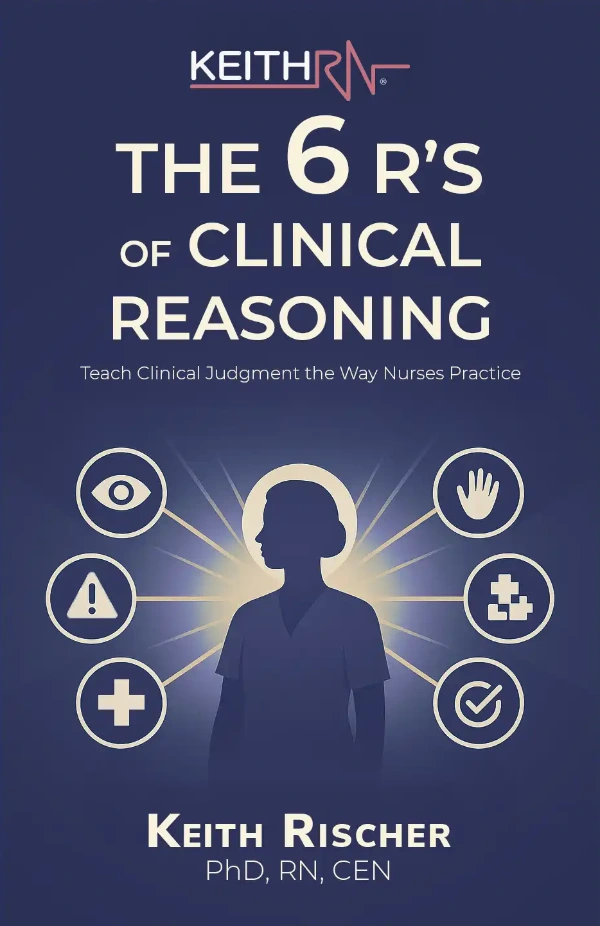
If a student came to clinical with no stethescope and/or name badge because it was forgotten, most educators would have no problem sending this student home and would not be allowed in the clinical setting.
Why?
Because he/she was clearly UNPREPARED and not engaged to enter this setting to learn and care for patients.
Yet students typically come to the classroom setting consistently unprepared.
This low bar of expectations needs to change in order to strengthen student learning!
A Question Worth Asking…
Why do educators expect students to come to clinical prepared, but not in the classroom?
Student unpreparedness to class is not only tolerated but expected by some faculty who complain that “students just won’t read” and accept this current reality and provide content heavy lectures that “spoon feed” the content they want so they know what to study for the test.
This is not an isolated problem. Based on feedback from faculty across the country where I have presented, this is the lived reality of nurse educators today:
- Students not engaged or motivated to participate in their learning
- Students EXPECT to be “spoon fed” content so they know what will be on the test
- Some students don’t even bother to purchase a textbook because they expect faculty to “cover the content” and religiously review the PowerPoint slides and lecture notes that are provided instead.
“Houston…we have a problem”
If you step back and assess this current struggle that many have in the classroom, what does it communicate about the current state of nursing education?
Nursing education continues to be in need of RADICAL TRANSFORMATION!
In order to transform nursing education, students must not only KNOW content, they must be able to USE and APPLY this content to the bedside where it matters most (Benner, Sutphen, Leonard, & Day)!
Class time needs to look like clinical in order to strengthen student learning and transform nursing education. Therefore the classroom should have the same level of PREPAREDNESS as the clinical setting because nursing is a PRACTICE based profession and educators must do what is needed to prepare students for professional practice.
I believe that nursing educational culture can be changed, but it will require courageous faculty who are willing to risk the wrath of entitled students who overtly or covertly dictate how they should be taught.
Three PRINCIPLES Needed to Change Classroom Culture
I would like to share THREE principles that highlight why educators must insist that students come to class prepared:
1. Preparation for clinical begins with DEEPLY understanding classroom content
In order to be SAFE in the clinical setting students must deeply UNDERSTAND essential content from lecture/textbook content.
This mastery does NOT come by just showing up for class but be repeated exposure to the content. First the student reads the textbook BEFORE lecture. This often results in questions that can be clarified in class.
Then the educator should be using active learning that will require practical application by the student. Coming to class prepared will facilitate this learning process
Memorizing content or writing out drug information verbatim out of the nursing drug manual on a med sheet is not the same as UNDERSTANDING what has been taught.
I see this illustrated consistently with my students in the clinical setting when assessing content knowledge of the meds they are going to give their patient.
When preparing to give atenolol, I will ask them what category is this medication, and students are able to identify this med as a beta blocker. But when I ask the next question that assesses their UNDERSTANDING, “What is a beta blocker blocking?” I get an empty stare and most are unable to give a concise explanation of the mechanism of action.
See for yourself how strong your students really understand pharm. Next week in clinical ask them:
- What is a beta blocker blocking?
- What is a calcium channel blocker blocking?
- What is an ACE inhibitor inhibiting?
Based on their response, now you will really know how much they truly understand pharmacology, and the response may surprise you!
2. In order to critically think, students must be able to USE knowledge
Once essential content is deeply understood, students must then be able to USE or APPLY knowledge to practice. Students must see themselves as an ACTIVE PARTNER in the educational process not a PASSIVE ABSORBER!
Using the same example of pharmacology understanding, once a student UNDERSTANDS what a beta blocker is blocking, they will be able to USE this knowledge.
If a student understands what a beta blocker is blocking, ask them what are the most common side effects and what nursing assessments are required after administration.
They will recognize that a beta blocker is blocking beta (fight/flight receptors) on the heart that will lower heart rate and blood pressure. Therefore both HR and BP must be assessed both before and afterwards and that orthostatic hypotension is an expected side effect.
Ask a student who has merely memorized this same content, they will be UNABLE to USE knowledge and will be completely dependent on their drug manual or drug card to give the same information.
3. In order to critically think, students must be able to CONSTRUCT knowledge
Construction of knowledge is the highest level of Blooms taxonomy and should be the goal to strengthen learning as well as the critical thinking of students.
Because of the high level of thinking that is required, students must have a basic understanding of what is going to be taught so they can better UNDERSTAND, USE, and CONSTRUCT knowledge!
Having students create their own case studies based on the lecture topic in small groups is an excellent pedagogy to make construction of knowledge possible.
Practical Steps to Change Classroom Culture
Begin by taking all THREE of the following steps in your content/program:
1. Communicate expectations for classroom preparedness
Just as you clearly communicate expectations for students to come to clinical prepared so they are not sent home, do the same in your classroom!
Communicate that you EXPECT every student to have read the textbook BEFORE the lecture. Then have an active learning tool that you have posted ahead of time (I used my case studies) and have them bring this to class having worked through this as their “ticket” to class.
Even as a newer nurse educator, I quickly learned that students will do just about anything for an extra point or two!
Use this to your benefit by doing a short 3-5 question quiz at the beginning of class based on the textbook readings for 1-2 bonus points. Those that did not read will come better prepared next time!
2. Bring ACTIVE Learning consistently to every lecture
Students must be ACTIVE partners in learning. Therefore bring ACTIVE learning to each lecture. Clinical reasoning case studies are my personal favorite and are still one of the most effective tools to teach a practice based profession.
I currently have 25 case study topics across all specialties that have both a blank student version and fully developed answer key so they can be immediately put to use in your classroom.
I have found that by splitting each lecture hour 50/50 with a hybrid flip; one half for lecture of NEED to know content, one half for ACTIVE learning/application was an effective model for my classroom.
3. Appeal to student desire to be the best.
Entitlement has become the new norm in our culture and society. Instead of the hard work and reaping the fruit of what has been diligently sown, some students EXPECT a passing grade just because they showed up and paid for the credits.
Call out this unprofessional behavior and make it clear that ACTIVE learning with required PREPARATION is needed to be the best nurse possible.
Appeal to this higher motive to BE THE BEST. Passive learning and spoon feeding may be enough to pass the test, but it will NOT prepare students to safely care for patients.
Remind students that they are caring for people of infinite value and worth. The inability to transfer learning to the bedside of patient care can result in “failure to rescue” with a status change and lead to adverse outcomes including patient death.
In Closing
Do NOT settle for the status quo, but do what is needed to bring needed change to your program by changing the culture in your classroom and expect students to come to class prepared.
Make learning ACTIVE and give yourself permission to have fun by using relevant tools that will require your students to be engaged and participants in their learning.
When I became the “guide on the side” instead of the “sage on the stage”, I had a lot more fun teaching, and my students came to value and appreciate this higher bar of student preparation and participation as they transferred classroom learning to the bedside in clinical.
This can be your experience as well! What do you have to lose by doing things differently? Take that first step and you will never look back!
What do you think?
What have you done to change culture to encourage student preparation in your classroom?
Comment below and let the conversation begin!
References
Benner, P., Sutphen, M., Leonard, V., & Day, L. (2010). Educating nurses: A call for radical transformation. San Francisco, CA: Jossey-Bass.
Keith Rischer – PhD, RN, CEN
As a nurse with over 35 years of experience who remained in practice as an educator, I’ve witnessed the gap between how nursing is taught and how it is practiced, and I decided to do something about it! Read more…
The Ultimate Solution to Develop Clinical Judgment Skills
KeithRN’s Think Like a Nurse Membership
Access exclusive active learning resources for faculty and students, including KeithRN Case Studies, making it your go-to resource.




